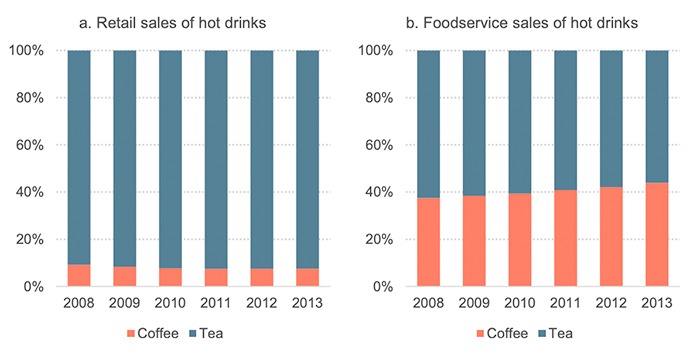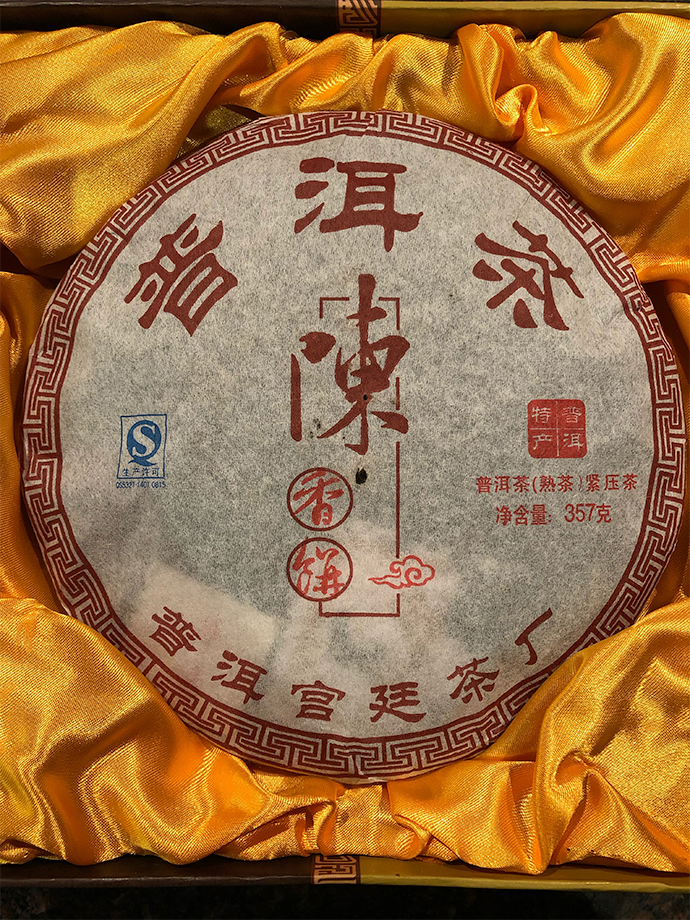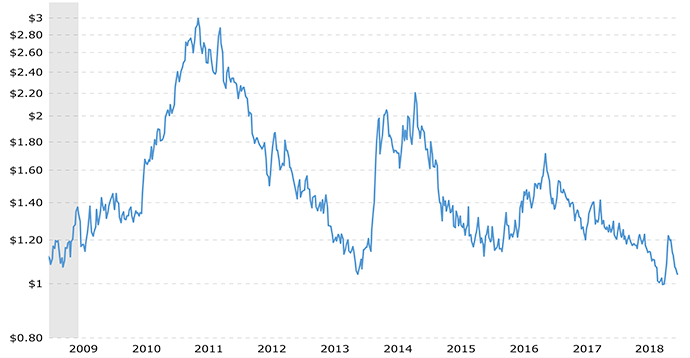- December 17, 2018
Slow Brew: China’s Coffee Revival and Globalization
Coffee is a widely traded commodity with a global market estimated at around $20 billion. But to most Chinese, coffee is a curious drink that signifies many things. It is both a status symbol of modernity and a reflection of intensifying social stratification, an importation of the Western lifestyle and an opportunity to build a globally recognized domestic industry.
For the vast majority of Chinese, a “Grande” Starbucks black coffee that sells for more than $3 in Beijing is an unaffordable luxury, considering the average household’s monthly disposable income is equivalent to just 90 cups of Starbucks coffee. In 2011, an intensely personal essay titled “I fought for 18 years just to have a coffee with you” went viral on the Chinese internet. The author was a migrant who had finally made it into the Shanghai elite and who used Starbucks as both a proxy of social status and a poignant symbol of the gulf between the haves and have-nots. At the time, China’s Gini coefficient, a widely used measure of inequality, hovered around 0.47 (the US sits at 0.42), one of the highest among major economies.
Nevertheless, a new generation of aspirational Chinese consumers has helped coffee boom across the country for more than a decade. And from 2011 to 2017, the coffee market (both roasted and instant) saw average revenue growth of 37% over that period. As the number of Chinese coffee-drinkers is estimated to be 200 to 250 million and rising, it is no surprise that Starbucks, which entered China in 1999, plans to nearly double the number of stores there to over 6,000 by 2022.
But coffee in China isn’t just about the collision between contemporary café culture and traditional tea culture nor the reliance on imports and mega-franchises like Starbucks. It is also anchored in the ambition of a single province—Yunnan—to sell Chinese coffee to the world by adopting foreign practices, tapping into mature markets overseas, and embedding domestic producers in a global industry of seasoned coffee purveyors and Western consumers.
China’s coffee industry is still relatively small and immature compared to coffee superpowers like Brazil and Vietnam, but it has grown tremendously from virtually nil 30 years ago (see Figure 1). This growth, and coffee’s future potential, is emblematic of how Chinese consumers have been reshaped by, and how this domestic industry depends on, globalization.
Figure 1. Coffee Production of Select Countries 2005-2015 (in 60kg bags)
Sources: International Coffee Organization; Yunnan Statistical Yearbook; Xinhua; author calculations.
None of this would’ve been possible without both parts of “Reform and Opening” operating in parallel—that is, domestic agricultural reforms and a surprising willingness by the Chinese government to open up this consumer market to massive foreign investment.
Latecomer to the Caffeine Rush
Coffee arrived in Yunnan—literally “south of the clouds” in Chinese—in 1892 via a French missionary who brought seeds for the locals in Binchuan County. The commodity was new to this poor agrarian province in southwest China, but the seeds of the global coffee industry had been planted as early as the 9th century, when it was first discovered in the Kaffa region of Ethiopia (the origin story of coffee is murky, however). Even in Asia, China’s neighbors got the taste of coffee earlier, when the Dutch introduced coffee to Indonesia in the 1600s and later to Taiwan.
Not only was China a late adopter of the product, its government also allowed the coffee industry to languish for nearly a century after its introduction in the late 19th century.
Several factors likely explain this initial neglect. For one, coffee arrived in China just 20 years before the Qing dynasty’s collapse, which was followed by 65 years of unrest, revolution, civil war, and a command economy. Cultivating a crop that was beloved by Westerners and that locals couldn’t afford nor desired simply wasn’t on the agenda. In addition, the strong and enduring Chinese preference for tea means that coffee is a niche beverage (see Figure 2). Finally, although Yunnan sporadically experimented with coffee starting in 1914, by the 1950s, its beans were struck by disease, which dramatically shrank the acreage of coffee planted.
Figure 2. Tea vs. Coffee in China
 Source: Euromonitor International.
Source: Euromonitor International.
Reviving Domestic Coffee
But not all was lost. In fact, not only does Yunnan share a border with Vietnam, a major coffee producer in its own right, the province is one of the few in China that could actually support a coffee industry. Although the province sits just above the “Bean Belt”—the band between the Tropic of Cancer and the Tropic of Capricorn where conditions are ripe for growing coffee—Yunnan’s micro-climates and elevation are conducive to the plant.
The revival of coffee production cannot be separated from the broader rural reforms that launched Reform and Opening in 1978. Indeed, economic reforms began on the farm, as the massive communes formed under Mao Zedong were abandoned in favor of a “household responsibility system” in which farming collectives had more control over their own plots of land. The Chinese government also changed incentives by allowing farmers to sell surplus production above a state quota at higher market prices, thereby significantly bolstering national production.
In agricultural provinces like Yunnan, local governments played a large role in determining the flexibility of the land use policy and also in supporting particular industries. About a decade after Reform and Opening began, the Yunnan government in 1988 took a gamble and embarked on a joint UN Development Program project with Nestlé and the World Bank to lay the groundwork for the expansion of domestic coffee production. From the get-go, salvaging China’s coffee industry required a joint venture because major conglomerates like Nestlé had the knowledge and resources that Chinese farmers needed to jumpstart a dying industry.
Local government resources, coupled with continued progress in agricultural land use policy, created dramatic results. With only about 4,000 hectares of coffee in the 1950s, Yunnan by 2013 had planted 43,000 hectares, a ten-fold jump. Today, Yunnan produces 99% of China’s coffee (the remainder is concentrated in Hainan and Fujian and is entirely Robusta). In short, the Chinese coffee industry is Yunnan, literally.
From Tea to Coffee
Perhaps the biggest irony is that the region in Yunnan that now accounts for about 60% of China’s total coffee production is Pu’er, known to many as the home of perhaps one of the most unique and supposedly healthy Chinese teas. The other two regions of coffee production are Baoshan and Dehong, where China’s largest private coffee producer, Dehong Hogood Coffee, is based (see Figure 3). The three regions combined now generate output that’s estimated to be worth nearly $500 million.
A Block of Pu’er Tea
 Source: Author.
Source: Author.
Figure 3. Key Regions of Coffee Production in Yunnan
Note: Data is for 2010; Pu’er’s market share has increased since.
Source: Arabica Coffee Production in the Yunnan Province of China.
It’s not that Yunnan has given up on tea, which continues to be a major local industry. Rather, local farmers are voting with their wallets, as coffee has fetched good money in recent years. Yunnan coffee prices had risen to as high as 40 yuan/kg in 2011 before falling back to around 15 yuan/kg in 2016. This appears to follow global coffee price fluctuations that peaked around 2011 and is near bottoming out again in 2018 to just above $1/pound (see Figure 4). When it comes to the single-origin coffees that pervade high-end cafes in the West—a small percentage of overall production—producers reportedly can still get 40 yuan to 50 yuan/kg.
Figure 4. Global Coffee Prices Since 2009 (in $/pound)
 Source: www.macrotrends.net.
Source: www.macrotrends.net.
Still, coffee is prone to price volatility, and it’s always a risk for farmers to switch to coffee from tea or rubber, both of which are major cash crops in Yunnan. This uncertainty has led to fluctuations in coffee production in various years, as farmers tend to chase the most profitable crop of the moment. In a bid to become more of a price-maker in coffee, Chongqing has decided to establish itself as a trading hub for coffee—in part because it borders Yunnan—and had cleared some $2 billion of trades at its coffee exchange as of 2017.
Yet China is still a long way from becoming a price-setter when volumes being traded in London and New York are much larger. In addition, the International Coffee Organization, which issues daily price indicators, is also based in London.
While some Chinese farmers have become dedicated to sustaining the coffee industry in Yunnan, whether the industry as a whole moves more aggressively into specialty coffees depends largely on foreign demand. However, shifts in domestic consumption patterns may increasingly play a role.
When it comes to domestic consumption, tea still overwhelmingly dominates, with more than 626,000 tons consumed in 2015 compared to just 68,000 tons of coffee. But its low base also means that coffee, unlike tea, is far from a saturated market in China. And a Chinese middle class that is projected soon to become bigger than the entire US population seems to promise future demand growth for the bean.
Putting Yunnan Coffee on the Map
A display of freshly roasted and carefully packaged whole beans sits along the counter in La Colombe Coffee Roasters in Manhattan’s “Noho” neighborhood. Among the Central American and African beans that dominate the counter nestles a coffee from Yunnan. This is both surprising and significant.
Yunnan Coffee Carried By La Colombe Coffee Roasters
 Source: Author.
Source: Author.
It is surprising because most American consumers have no idea that China even produces coffee, let alone could point out Yunnan on a map. The majority of coffee Americans drink comes from Central and South America. It is significant because the fact that a Chinese coffee, an unknown quantity just a few years ago, has been recognized for its premium quality by one of the largest artisan coffee purveyors in America should raise eyebrows. It is a status designation that would elicit envy in the Chinese wine industry, where success in garnering global attention for domestic brands has been elusive.
La Colombe, like its peers, counts itself part of the so-called “third wave” of coffee that has elevated the coffee experience as comparable to that of wine. A new generation of coffee traders, roasters, and artisans now scour the world for the best beans, perfect roasting and brewing techniques, and advocate fair compensation for coffee farmers. Consumers in the West, meanwhile, have by and large bought into the notion of coffee as an experience rather than a mere commodity, demonstrated by their willingness to pay premiums for higher quality.
Indeed, coffee has always been an industry in which most of the consumption takes place in developed countries and where the supply comes almost exclusively from developing countries. That a Chinese coffee has risen to meet the standards of a leading American artisan coffee roaster is somewhat curious. It reflects both the changes in the domestic industry and among Chinese consumers over the last few years—it is one of the few countries in which domestic production of high-quality coffee could tap increasingly sophisticated and wealthier domestic consumers.
Japanization of Chinese Coffee?
To see a potential future for coffee in China, one could look to its East Asian neighbor Japan. Like China, Japan has an entrenched tea culture yet also boasts one of the most sophisticated coffee cultures in the world. That culture began developing in the 1930s as thousands of kissaten (traditional Japanese cafes) popped up around the country. In short, Japan was making artisan coffee long before it was considered “cool” in the United States, which is why most of the hand-pour brewing equipment in high-end cafes in America is imported from Japan.
But, unlike China, Japan does not produce coffee. And given that its annual consumption is significant, it has no choice but to rely entirely on imports (see Figure 5).
Figure 5. Japan Overshadows China in Coffee Imports (in 60kg bags)
*Includes both Hong Kong and mainland China.
Sources: International Coffee Organization; Yunnan Statistical Yearbook; Xinhua; author calculations.
Many Japanese kissaten have disappeared since their peak in the 1980s, partly due to urban gentrification and partly to the rising market share of large chains. But these dynamics seem to be operating in reverse in China. That is, the Starbucks and Nestlés gained dominant positions in the China market first, but it is only now that Chinese consumers, as well as a growing crop of local purveyors, are entering the market—at a time when the global coffee industry en masse is shifting to specialty beans and higher quality.
Foreign incumbents are also facing new challenges from local upstarts such as Luckin Coffee, which has been valued at more than $2 billion after its latest fundraising. These emerging dynamics may be a turning point for a Chinese coffee industry that is poised to become increasingly global just as its consumers become aligned with the coffee culture of the moment.
To be sure, China still has a long way to go simply to reach the consumption level of Japan, and it is this overwhelming gap that implies an enormous potential windfall for coffee remains unfulfilled (see Figure 6). For instance, Chinese coffee consumption has been growing at about 15% a year, much higher than the global average of 2%.
Figure 6. Coffee Consumption of China vs. Japan (in 60kg bags)
Sources: Wind; Statista.
China now consumes roughly 3.7 million bags of coffee annually, still less than half that of Japan. In essence, China resembles late-1970s/early-1980s Japan when it comes to total coffee consumption. The difference is even more striking on a per capita basis: for China, it’s only about 4-5 cups per year; for Japan it’s about 360 cups and for the United States it’s roughly 400 cups. Even back in the 1980s, the Japanese were already consuming an average of seven cups a week. That is to say, if China reached just a quarter of Japanese per capita consumption in the 1980s, the coffee market would see tremendous growth.
While instant coffee still dominates Chinese consumption (see Figure 7), there appears to be plenty of room for both foreign brands to entrench their positions and for the emerging legion of domestic artisan purveyors to establish themselves as industry leaders.
Figure 7. Instant Coffee Rules China
Source: Qianzhan Industry Research.
One such domestic retailer is Seesaw Coffee, a specialty purveyor not so dissimilar from La Colombe. According to the company, over the last four years, it has become the largest domestic buyer of specialty beans from Yunnan and has employees based in the province who work directly with farmers. The owner and baristas take their inspiration from the Chicago-based Intelligentsia café chain and from Japanese coffee culture, and the company also offers training to local farmers on coffee processing and sustainable practices.
Seesaw is hardly alone. New Chinese artisans are connecting with the global coffee culture. Even incumbents like Starbucks are adapting and jumping into the fray. It too has debuted its first single-origin Yunnan coffee, and has invested in training centers to help local farmers improve the quality of their beans. The American company has also been increasing its purchases from the province in recent years. In 2014, Starbucks bought 14,000 bags of Yunnan coffee for export, up from 2,600 bags in 2013. Though this is a blip in Starbucks’ global purchases, it nonetheless represented over 50% of Chinese coffee exports to the United States.
Embracing Globalization
Starbucks is a behemoth, but it once was the pioneer in selling coffee as an experience rather than a mere caffeinated commodity. Rather than deviating from that strategy, the Seattle coffee giant has doubled down on it by investing in flagship roasteries around the world, with the largest in Shanghai.
That kind of experience may not be within reach for most Chinese, yet without the likes of Nestlé and Starbucks, China today may not have had a coffee industry to speak of. It was foreign knowhow and direct linkages to a global market of consumers that resuscitated a dying industry (see Figure 8). Yunnan coffee has found a second life, one that is highly encouraged by the local government. Its recent success has brought the world to this southwest corner of China in search of the next big thing in coffee.
Figure 8. Private Players Dominate Market Share
Note: Data is only for 2009.
Source: International Trade Centre.
Unlike the Chinese wine industry, largely composed of state-owned firms, the coffee business relies on a tapestry of private domestic firms, major foreign-invested ventures, a hodgepodge of independent local purveyors, and access to global markets and culture. All of which are results of accommodative agricultural reforms and the enormous openings that took place over the last 30 years, particularly in consumer markets.
Yunnan coffee would not have ended up in American cafes without this combination of factors that allowed an immature industry to punch above its weight and earn recognition via ambassadors in coffee-consuming, wealthy countries. Starbucks may have trailblazed the “coffee as an experience” concept, but it no longer has a monopoly on it in China.
Stay Updated with MacroPolo
Get on our mailing list to keep up with our analysis and new products.
Subscribe
